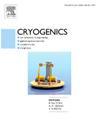准各向同性链接触电阻率H公式的数值模拟
IF 1.8
3区 工程技术
Q3 PHYSICS, APPLIED
引用次数: 0
摘要
准各向同性股(Q-IS)是一种具有优异电磁性能和力学性能的高温超导电缆。本文采用带接触电阻率的H公式来模拟Q-IS的电磁行为。为了验证模型的可靠性,将模型的数值结果与文献中的实验数据进行了比较,两者在定性上是一致的。当Q-IS单独受到输运电流或交变外磁场作用时,电流和磁场的分布都是对称的。特别是当Q-IS暴露于交变外磁场时,其磁化损失呈对数线性增加。然而,当输运电流和外加磁场同时施加时,Q-IS的损耗不再随外加磁场幅值的变化呈对数线性增加。此外,电流和磁场的分布图表现出明显的不对称性。本文章由计算机程序翻译,如有差异,请以英文原文为准。
Numerical simulation in quasi-isotropic strand by the H formulation with contact resistivity
The quasi-isotropic strand (Q-IS) is a type of high-temperature superconducting (HTS) cables, which has the excellent electromagnetic and mechanical properties. In this paper, the H formulation with contact resistivity is employed to simulate the electromagnetic behavior of Q-IS. To validate the reliability of the model, a comparison between the numerical results from our model and experimental data from the literature is presented, which are in qualitative agreement. When the Q-IS is subjected to either a transport current or an alternating external magnetic field alone, the distribution of both current and magnetic field is symmetric. Particularly, when the Q-IS is exposed to the alternating external magnetic field, the magnetization losses of Q-IS show a log-linear increase. However, when both the transport current and external magnetic field are applied simultaneously, the losses of Q-IS no longer increase log-linearly with changes in the external field amplitudes. Additionally, the distribution maps of current and magnetic field exhibit a noticeable asymmetry.
求助全文
通过发布文献求助,成功后即可免费获取论文全文。
去求助
来源期刊

Cryogenics
物理-热力学
CiteScore
3.80
自引率
9.50%
发文量
0
审稿时长
2.1 months
期刊介绍:
Cryogenics is the world''s leading journal focusing on all aspects of cryoengineering and cryogenics. Papers published in Cryogenics cover a wide variety of subjects in low temperature engineering and research. Among the areas covered are:
- Applications of superconductivity: magnets, electronics, devices
- Superconductors and their properties
- Properties of materials: metals, alloys, composites, polymers, insulations
- New applications of cryogenic technology to processes, devices, machinery
- Refrigeration and liquefaction technology
- Thermodynamics
- Fluid properties and fluid mechanics
- Heat transfer
- Thermometry and measurement science
- Cryogenics in medicine
- Cryoelectronics
 求助内容:
求助内容: 应助结果提醒方式:
应助结果提醒方式:


